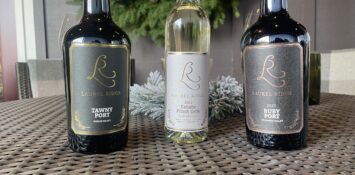An Expert’s Guide: Tips and Tricks for Your Best At Home Pie

Are you baking pies this holiday season? Feeling intimidated? Don’t worry – here at Laurel Ridge Winery, we have you covered, from the best wine pairings for any pie, to creating the best ever from scratch pie.
One of our culinary consultants, and the chef behind our wine club release parties, Kevin Bechtel, just so happens to be a “pie champion” (literally). He has over 35 years of experience in the food and restaurant industry. An award winning chef, he is a former Board Member, Board President, and Chair of the International Corporate Chefs Association, as well as a Board Member, Board President, and Chair of the Oregon Restaurant Association. His awards include the prestigious Menu Master’s Award in 2011, and the IFMA Culinary Innovation Award in 2012. Over the course of his career, he has been awarded over 60 medals at the National Pie Championships.
Now to me of course, Kevin is better known as my dad. Over the years, a pattern has emerged…every Thanksgiving Eve, Kevin’s phone blows up with every food question imaginable. But the most requested topic of help is always the pie. Because really – is it even Thanksgiving without SOME sort of pie?! From pumpkin pies that just won’t set, to pecan pies that bake too quickly, to burned apple pie crusts…Kevin has heard it all. I asked my dad to share some of his best tips and troubleshooting for pies.
Pick the right dish, and bake accordingly:
Did you know that the color of your pan will affect how your pie bakes? Set yourself up for success by selecting the best pan.
Shiny pans, dark pans, and glass pans all cook differently. When baking a pie in a glass or ceramic pie pan, Kevin recommends baking at 25 degrees under the recommended temperature – so if your recipe calls for baking your pie at 350 degrees, he would recommend 325. Additionally, dark metal pans (or shiny pans) will cook the pie more quickly and produce a browner crust.
And don’t forget – always keep your pie dishes in the refrigerator until the last possible moment!
Creating the perfect pie crust is all about temperature. Why is it so important that everything is cold, you ask? “All of your ingredients should be cold – you can even put the flour in the fridge, as well,” Kevin explains. “The warmer your ingredients are, the stronger the gluten link will be, resulting in a tougher crust.”
- Keep the butter ice cold. Kevin swears by this. “I cut mine into chunks, and then put it into the refrigerator until I am ready to get it cooled back down. If it’s just going to be for a couple minutes, I’ll even pop it in the freezer.”
- Make a pitcher of ice water…then pour out the amount of water you need. Or, he explains you can even substitute up to half of your ice water with ice cold Vodka. “It doesn’t create glutens when you knead the dough, the alcohol burns off, and it’s flavorless, so no one is the wiser. Sometimes it can help ensure a very cold crust when kneading.”
- A reminder – keep your pie pans in the fridge until you are ready to use them! He means it. Seriously.
Make sure your crust is well ventilated. Aside from being beautiful, Kevin explains that one of the appeals of a lattice crust it releases steam, resulting in a flaky, decadent crust. “If you’re trying to make a double vented pie, you have to make sure your slits are large enough to properly release steam.” Kevin recommends vents that are 2.5 to 3 inches in length. He also says this can be viewed as an opportunity to get creative. “Not everything has to be a complicated lattice. Think of fun decorating ideas like using cookie cutters to make holes, or using cookie cutters to make apples and leaves.” One of the additional benefits of these creative crusts? Better ventilation!
Trust the process – be patient when baking. Kevin says that one of the biggest mistakes novice bakers make is simply a lack of patience.
- Always let your pie cool completely. It doesn’t matter whether it’s a pumpkin, custard based, pecan, or fruit pie – all pies should be allowed to cool completely, for at least an hour. Kevin explains that this helps the pie “set” and allows for continued ventilation of the hot filling- which helps ensure a moist, flaky crust!
- Your pie might jiggle. That’s okay. Pumpkin pies are notorious for the “jiggle”, but any custard based pie is prone to this. Kevin says you have got to remember that pies continue baking once they are removed from the oven – that’s why we must allow them to completely cool first, before enjoying! “A pumpkin or custard pie might seem too jiggly, but as soon as the pie cools, it will have fully set.
- Bake your crust on the lower rack. Heat rises – so a pie that is baked on the upper racks will brown too quickly. Check on your pie at 10 to 15 minute intervals – if the pie is beginning to brown too quickly, you can always tear off a piece of foil to cover it. Just remove the foil for your last 5 minutes of baking to make sure you get that perfect, toasty brown crust!
Remember to tag us on social media so we can see your pies! And if you have any further questions for Kevin, drop us a comment or a message! We’ll reach out to get your question answered!

Now stay tuned…if you want your lattice to look great and confidently know how find the perfect wine pairing for any pie, be sure to watch for my next blog post on decorating and serving the perfect pie!

